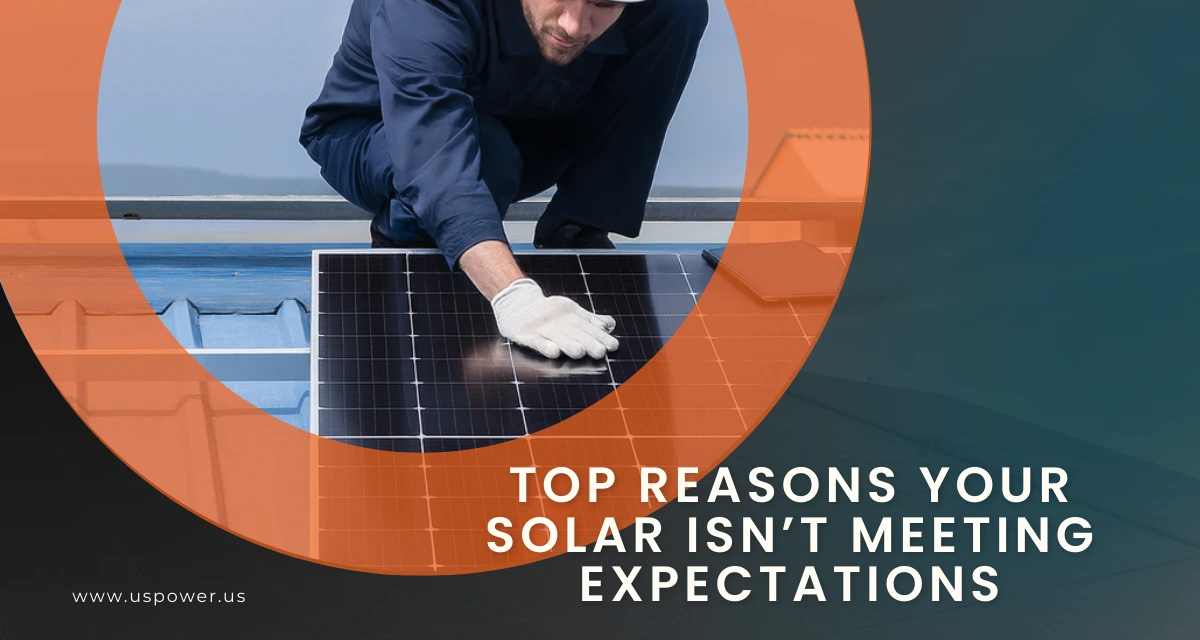Why Large Solar Providers Can Charge Unexpected Fees

Solar and Roofing Advisor
Avoid $1,500+ surprise charges with US Power. Get full transparency on panels, battery placement, and incentives for Southern California homes.

Imagine this: you decide to go solar. You vet the big names, pick a national provider like Sunrun, and sign a contract — but before any panels ever touch your roof, something doesn’t feel right. On the day of installation, you find out the battery they’re supposed to mount on the east side of your home (as per your approved plan) is now being placed on the west — your driveway. They tell you they need to redesign, so they cancel the install that day. Weeks pass. No work is done. Still, months later, you receive a bill: $1,500 for “electrical updates… labor, permitting plans, engineering plans, contract processing, and general project management.”
You thought you were protected — after all, they said you wouldn’t be charged unless the panels were installed. But now you're stuck with an unexpected fee, and it stings. You're not alone. This is a real case many homeowners have faced, and it's a cautionary tale about what can go wrong when communication, contract details, and transparency are missing.
If this sounds like your worst-case solar scenario — welcome to why choosing US Power, a top local solar company, with a direct partnership with QCells, can be the smarter, safer, and more predictable way to go solar in Southern California.
Why These Surprise Charges Happen: Common Pitfalls with Large Solar Providers
To understand what went wrong in the story above, let’s break down the typical missteps that can lead to unexpected fees and homeowner frustration:
Misaligned Plans vs. Final Design
Sometimes, the plans your salesperson shows you aren’t the same plans the field team uses. In this case, the battery placement was flipped, triggering a need for design changes — which then triggered engineering, permitting, and project-management fees.
These changes are real work, but without clear, written confirmation of what constitutes “construction,” companies may try to bill for them — even if no hardware has been installed.
Ambiguous Contract Language
Phrases like “you won’t pay until panels are installed” sound good — but unless “commence construction” is clearly defined in the contract, “design work” or “permit drawing” might count as their start of work.
In some contracts, preliminaries (site survey, plan design, engineering) are billed even if the physical install never happens.
Cancellation Windows vs. Construction
Many companies offer a “right to cancel” window (5 days, for instance), but once work begins (even just planning), they may argue that your free cancellation rights end.
If the contract doesn’t define “construction,” this becomes a gray area and a source of disputes.
Hidden or Deferred Costs
Even though the homeowner was charged for “electrical updates,” no physical work was done. This suggests that the fees may be for planning or compliance rather than actual installation.
Without itemized billing (showing exactly what was done), it's hard to dispute these charges effectively.
Power Imbalance
Large companies like Sunrun have legal and billing teams dedicated to enforcing these contract clauses. For individual homeowners, fighting them can feel daunting — especially if you’re not sure whether they’re right or wrong.
Why Local, Transparent Installers Like US Power Are a Safer Bet
Here’s how US Power helps you avoid those kinds of surprise bills and gives you control — especially in Southern California:
Factory-Direct QCells Panels & Battery Systems
We partner with QCells, a leading, American-made solar manufacturer (inside the QCells factory), so we cut out the middleman. That helps us control cost, quality, and transparency.
Clear and Honest Proposals
When you work with US Power, you receive a detailed, line-item proposal. This includes engineering, permitting, battery mounting, and project management — so you know exactly what you're paying for, and why.
We make sure to confirm approved design plans with you before any “construction” phase begins (even if that’s just planning, so there are no late surprises).
Learn more in our homeowners guide to buying solar panels in SoCal.
Defined “Commencement of Work”
In your contract, we clearly define what “construction” means — whether that’s drawing up plans, running site surveys, or actual hardware installation — so there’s no ambiguity about when billing may start.
Local Project Management & Communication
Because we’re locally based, our team deals with your county, city codes, and permitting directly. We don’t pass off the work to third parties.
You have a project manager you can call — not just a 1‑800 line. We update you throughout design, permitting, installation, and inspection.
Full Incentive Management
We help maximize California-specific incentives (more on that below), especially for battery storage. We assist with SGIP applications, tax credit documentation, and more.
Check out our guide on how solar batteries can maximize your savings.
The Solar + Battery Advantage in Southern California (Especially in 2025)
Why Batteries Are Now Critical — Not Optional
Under California’s NEM 3.0 net-metering regime, your utility pays you very little for excess solar power sent back to the grid (often just 6–8¢ per kWh), while your cost to import electricity from the grid may be 30–40¢ per kWh (stay net metered while increasing capacity).
This makes battery storage far more valuable:
- You store excess solar instead of selling it for pennies.
- You use that stored energy during peak rate hours (like late afternoon/early evening), which is when electricity is usually most expensive.
- During power outages or Public Safety Power Shutoffs (PSPS), batteries provide resiliency — keeping essential loads running.
Incentives That Make Solar + Battery Cheaper Than Ever (But Time Is Running Out)
Federal Tax Credit (Residential Clean Energy Credit)
The 30% federal tax credit (previously the ITC) applies to solar panels, inverters, batteries, and installation.
Deadline alert: systems must be “placed in service” by December 31, 2025 to qualify for the full credit.
California SGIP (Self-Generation Incentive Program)
In June 2025, the CPUC launched a $280 million SGIP fund focused on solar + storage equity. Rebates for battery storage vary depending on your household and location.
For eligible homeowners, SGIP + the 30% federal credit can cover the bulk or even nearly the entire cost of a paired solar + battery system. Advanced payment options are available to reduce upfront costs.
California Property Tax Exclusion
Solar systems installed before January 1, 2027 are excluded from property tax reassessment (california solar property tax exclusion).
How US Power Designs Your Ideal Solar + Battery System (Without Surprises)
- Free Energy Assessment – We analyze your roof, electricity usage, and energy goals.
- Detailed Proposal & Design – Line-item breakdown for panels, inverters, battery, permitting, engineering, construction.
- Incentive Application & Permitting – We handle SGIP and all permitting; no surprise fees.
- Professional Installation – Certified, licensed installers mount your QCells panels and battery.
- Inspection & Activation – Coordination with local authorities and utility to obtain PTO.
- Ongoing Support & Monitoring – Performance monitoring and maintenance check-ins.
Real‑World Benefits for Southern California Homeowners
- Better Value from Your Energy – Store and use solar power when it’s most valuable.
- Resiliency for PSPS & Outages – Batteries keep essential loads powered during blackouts.
- Predictable Costs, No Surprises – Contracts define what triggers costs.
- Maximized Incentives – SGIP + 30% tax credit + property tax exclusion can dramatically reduce net cost.
- Local Expertise – We know SoCal’s building codes, utility structures, and permit processes.
What to Ask Before Signing with Any Solar Company
- When Does Billing Start?
- Can You Review Final Design Before Install?
- Are All Project Phases Itemized?
- Who Is Handling Incentive Applications?
- What Happens If You Cancel After Designs Are Done?
- How Do They Handle Disputes?
Act Now or Risk Missing Out
2025 is a critical year for going solar in California. Incentives like the 30% federal tax credit are available — but only until December 31, 2025. SGIP funding is live, but timing and eligibility matter.
Work with US Power, a local, transparent installer with direct access to QCells panels, deep SGIP experience, and a proven process that protects you from the kind of billing nightmare described above.
Ready to protect yourself from hidden solar fees?
Schedule for a free consultation.
Don’t risk surprise bills, unclear design changes, or “you can cancel anytime” promises that don’t hold up.
Related Articles
Our Related Blogs
Expert tips to maximize solar output in SoCal. Boost your solar efficiency with us.
Compare NEM 2.0 and NEM 3.0 to see how solar billing rules affect homeowners.
Discover why electricity costs keep rising and how solar can help lower bills.
Our Solar and Roof Brand Partners








We empower communities and businesses to harness clean, renewable solar energy solutions that drive sustainable growth.
Ready to Own Your Power? Call us today!
818-650-8010
Copyright © 2025 US Power - Axia by QCells. All Rights Reserved.
Privacy is important to us, so you have the option of disabling certain types of storage that may not be necessary for the basic functioning of the website. Blocking categories may impact your experience on the website.
Essential
These items are required to enable basic website functionality.
Personalization
These items allow the website to remember choices you make (such as your user name, language, or the region you are in) and provide enhanced, more personal features.
Marketing
These items are used to deliver advertising that is more relevant to you and your interests.
Analytics
These items help the website operator understand how its website performs, how visitors interact with the site, and whether there may be technical issues.
We and our third-party partners use cookies and other technologies to enhance and track your experience on this site, conduct analytics, and personalize marketing to you. By using the site, you agree to our use of these technologies, including recording and monitoring your interactions with the site.
Get an instant solar estimate using satellite!









